Canes Venatici constellation lies in the northern hemisphere. The constellation’s name means “hunting dogs” in Latin. Canes Venatici represents the hunting dogs of Boötes, the Herdsman, represented by the neighboring constellation. The two hunting dogs are known as Asterion and Chara.
The Greek astronomer Ptolemy included the stars of Canes Venatici in the constellation Ursa Major as informes (unformed stars), but the constellation was not introduced until 1687, when the Polish astronomer Johannes Hevelius created it from the faint stars located under the Great Bear’s tail.
Canes Venatici contains the famous stars Cor Caroli and La Superba and a number of interesting deep sky objects. These include the Messier galaxies known as the Whirlpool Galaxy (M51), Sunflower Galaxy (M63), Cat’s Eye Galaxy (M94) and Messier 106, the globular cluster Messier 3, the Whale Galaxy (NGC 4631), the Hockey Stick Galaxies (NGC 4656 and NGC 4657), and the Cocoon Galaxy (NGC 4490).
Facts, location and map
Canes Venatici is the 38th largest constellation in the sky, occupying an area of 465 square degrees.
It is located in the third quadrant of the northern hemisphere (NQ3) and can be seen at latitudes between +90° and -40°. The neighboring constellations are Boötes, Coma Berenices, and Ursa Major.
The constellation name Canes Venatici is pronounced /ˈkeɪniːz vɪˈnætɪsaɪ/. In English, the constellation is known as the Hunting Dogs. The genitive form of Canes Venatici, used in star names, is Canum Venaticorum (pronunciation: /ˈkeɪnəm vɪnætɪˈkɒrəm/). The three-letter abbreviation, adopted by the International Astronomical Union (IAU) in 1922, is CVn.
Canes Venatici has only one star brighter than magnitude 3.00 and two stars located within 10 parsecs (32.6 light years) of Earth. The brightest star in Canes Venatici is Cor Caroli, Alpha Canum Venaticorum. The nearest star, DG Canum Venaticorum (spectral class M4.0Ve), is only 25.89 light years distant from Earth. The constellation has four stars with known planets.
Canes Venatici contains five Messier objects: M3 (NGC 5272), the Whirlpool Galaxy (M51, NGC 5194, NGC 5195), the Sunflower Galaxy (M63, NGC 5055), M94 (NGC 4736), and M106 (NGC 4258). There is a meteor shower associated with the constellation, the Canes Venaticids, taking place in January.
Canes Venatici contains five named stars. The star names approved by the International Astronomical Union (IAU) are Chara, Cor Caroli, Komondor, La Superba, and Tuiren.
Canes Venatici belongs to the Ursa Major family of constellations, along with Boötes, Camelopardalis, Coma Berenices, Corona Borealis, Draco, Leo Minor, Lynx, Ursa Major, and Ursa Minor.
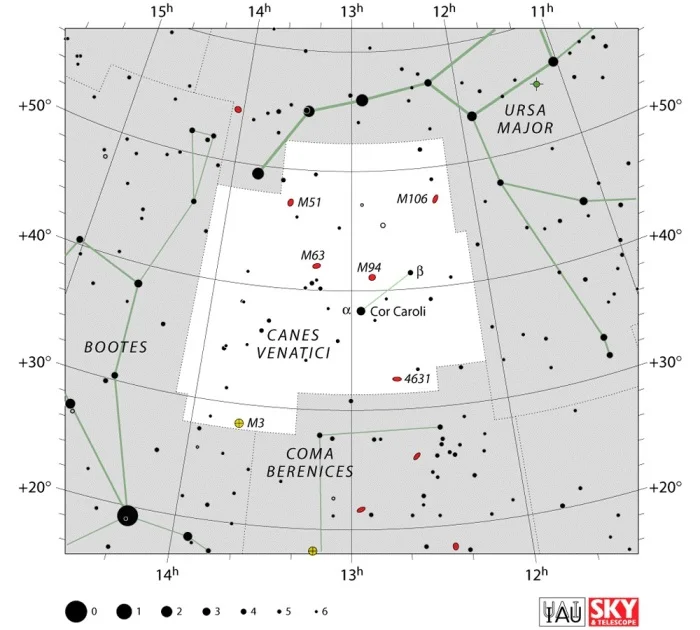
Canes Venatici constellation map by IAU and Sky&Telescope magazine
Story
In the Middle Ages, Canes Venatici was identified with the two dogs held on a leash by Boötes, the Herdsman, because there was a mistake in the translation of Ptolemy’s Almagest from Greek to Arabic.
In Ptolemy’s text, some of the stars in Boötes represent the Herdsman’s club. The translator loosely translated the Greek word for “club” (Κολλοροβος ) as “the spearshaft with a hook” (“al-`aşā dhāt al-kullāb”). When the Arabic phrase he used was later translated to Latin, the translator mistook one of the words for kilāb, which means “dogs.”
Boötes was depicted with two dogs in 1533 on a map by the German astronomer Peter Apian, and Hevelius decided to define the dogs’ position in the night sky in the 17th century. Hevelius named the northern dog Asterion (“little star” in Greek) and the southern one Chara (“joy”). The name Chara later started to be used specifically to refer to the star Beta CVn.
Canes Venatici stars
Cor Caroli – α Canum Venaticorum (Alpha Canum Venaticorum, α CVn)
Cor Caroli is the brightest star in the constellation, with an apparent magnitude varying between 2.84 and 2.98. It is approximately 110 light years distant. Its name means “Charles’ heart.”
The star was named by Sir Charles Scarborough, mathematician and physician to Charles II, in honour of Charles I, the king who met his end after the English Civil War, whose son was restored to the throne shortly after his passing. Alpha CVn was originally named Col Caroli Regis Martyris.
Cor Caroli is a binary star composed of two stars separated by 19.6 arcseconds in the sky. The brighter component, Alpha-2 CVn, is a chemically peculiar star that belongs to the spectral class A0 and is classified as an Ap/Bp star (one showing an overabundance of certain metals). The star has an unusually strong magnetic field, one 5,000 times as strong as the Earth’s, and its atmosphere has overabundances of europium, mercury and silicon.
Cor Caroli’s brighter component is a prototype of a class of variable star, the Alpha-2 Canum Venaticorum variables. These stars are notable for strong magnetic fields which are believed to produce enormous starspots which, in turn, cause the luminosity to vary significantly during the stars’ rotation.
The companion star, Alpha-1 CVn, is an F-type main sequence star with an apparent magnitude of 5.60.
Alpha CVn is part of the Great Diamond (or Diamond of Virgo) asterism, marking its northern vertex. Other stars forming the asterism are Denebola (Beta Leonis) in Leo, Spica (Alpha Virginis) in Virgo and Arcturus (Alpha Boötis) in Boötes.
Chara – β Canum Venaticorum (Beta Canum Venaticorum, β CVn)
Chara, Beta CVn, is the second brightest star in Canes Venatici. It is a G-type main sequence dwarf approximately 27.4 light years from Earth. The name Chara, which was originally used for the southern dog, means “joy” in Greek. The star has an apparent magnitude of 4.26. It is similar to the Sun in terms of age, mass and stage of evolution, and it has been called a solar analogue or solar twin.
La Superba – Y Canum Venaticorum (Y CVn)
La Superba is a well-known star in Canes Venatici and one of the reddest stars in the sky. It was named La Superba by 19th century Italian astronomer Angelo Secchi because of its striking appearance.
The star is believed to be in the last stages of fusing its secondary fuel, helium, into carbon. It is losing mass at a relatively fast rate and is surrounded by a disk of ejected material. Most likely, Y CVn will eject its outer layers (relatively) soon to form a nebula and become a white dwarf.
La Superba is a semi-regular variable star, with an apparent magnitude varying between 4.8 and 6.3 over a period of 160 days. It is the brightest J-star known. (J-stars are the rare carbon stars that contain an abundance of carbon-13.) The star lies about 711 light years from Earth.
AM Canum Venaticorum (AM CVn)
AM CVn is classified as a cataclysmic variable star, one that irregularly has dramatic increases in luminosity and then drops back to a quiescent state. Cataclysmic variables are typically binary stars, composed of a white dwarf and a mass transferring secondary star. The gravity of the white dwarf distorts the other star and the white dwarf accretes matter from it. The material falling from the donor star usually forms an accretion disc around the white dwarf.
AM CVn is a prototype of a class of variables known as the AM CVn stars. These stars are cataclysmic variables consisting of two white dwarfs, with the accretion disc composed mainly of helium. The stars are also interesting as a source of gravitational waves.
AM Canum Venaticorum has an apparent magnitude of 14.18 and is approximately 2,000 light years distant.
RS Canum Venaticorum (RS CVn)
RS Canum Venaticorum is another star in Canes Venatici that serves as a prototype for a class of variable stars. The RS Canum Venaticorum variables are close binary stars with variations in luminosity caused by the stars’ active chromospheres. The period of variations typically mirrors the orbital period of the star system. The stars’ luminosity typically fluctuates by 0.2 magnitudes.
Deep sky objects in Canes Venatici
Messier 3 (NGC 5272)
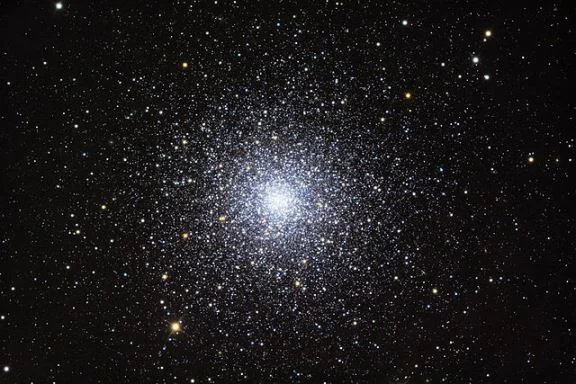
Messier 3, image: Adam Block/Mount Lemmon SkyCenter/University of Arizona (CC BY-SA 3.0 US)
Messier 3 is a globular cluster about 33,900 light years from Earth. It is one of the largest, brightest globular clusters known, containing about 500,000 stars. It was discovered by William Herschel in 1784.
The cluster has an apparent magnitude of 6.2. Its estimated age is 8 billion years.
Whirlpool Galaxy – Messier 51 (NGC 5194)
The Whirlpool Galaxy is one of the best known galaxies in the night sky. It is a grand design spiral galaxy located about 31 million light years from the Milky Way.
The galaxy, which is also known as Messier 51a, is interacting with NGC 5195 (Messier 51b), a dwarf galaxy, also in Canes Venatici. The galaxies are connected by a tidal bridge which is full of interstellar dust. The dust can be seen silhouetted against the center of the dwarf galaxy. NGC 5195 is highly distorted in shape because of its interaction with the Whirlpool Galaxy.
The Whirlpool Galaxy has an apparent magnitude of 8.4 and can even be seen with binoculars, along with its companion galaxy. M51 has a bright circular disk with a radius of 38,000 light years.
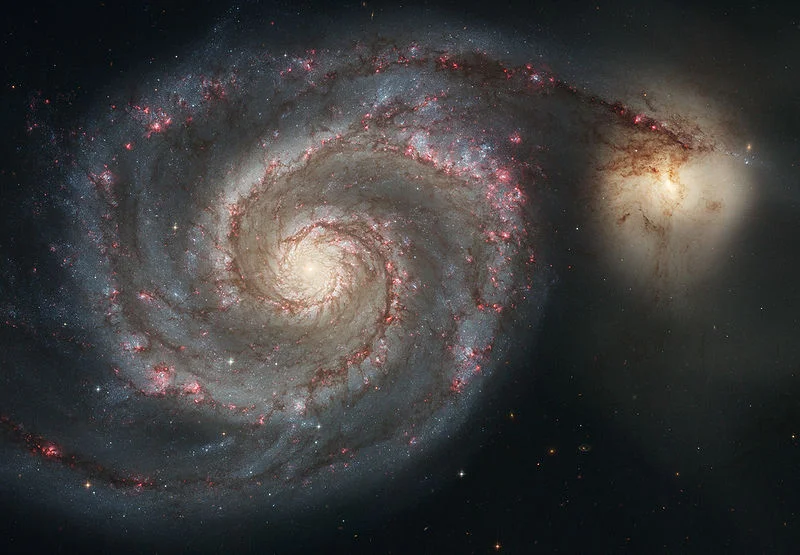
Whirpool Galaxy (Messier 51), photo: NASA, ESA, S. Beckwith (STScI), and The Hubble Heritage Team STScI, AURA)
The galaxy was first discovered by Charles Messier in 1774, while the dwarf galaxy NGC 5195 was discovered in 1781 by the French astronomer Pierre Méchain. In 2005, a supernova (SN 2005cs) peaked at apparent magnitude 14 in the direction of the Whirlpool Galaxy.
M51 never sets for observers north of 43°. It can easily be found by moving 3.5° to the southeast from Alkaid (Eta Ursae Majoris), the easternmost star in the Big Dipper asterism and the tip of the tail of Ursa Major.
Whirlpool is the brightest galaxy in the M51 Group, a group of galaxies in Canes Venatici that also includes the Sunflower Galaxy (M63), M51’s companion galaxy NGC 5195, and also NGC 5023, NGC 5229, UGC 8313, and UGC 8331.
Sunflower Galaxy – Messier 63 (NGC 5055)
The Sunflower Galaxy is the second brightest member of the M51 Group, after the Whirlpool Galaxy. It has an apparent magnitude of 9.3. It is a spiral galaxy with an apparent magnitude of 9.3, approximately 37 million light years from Earth.
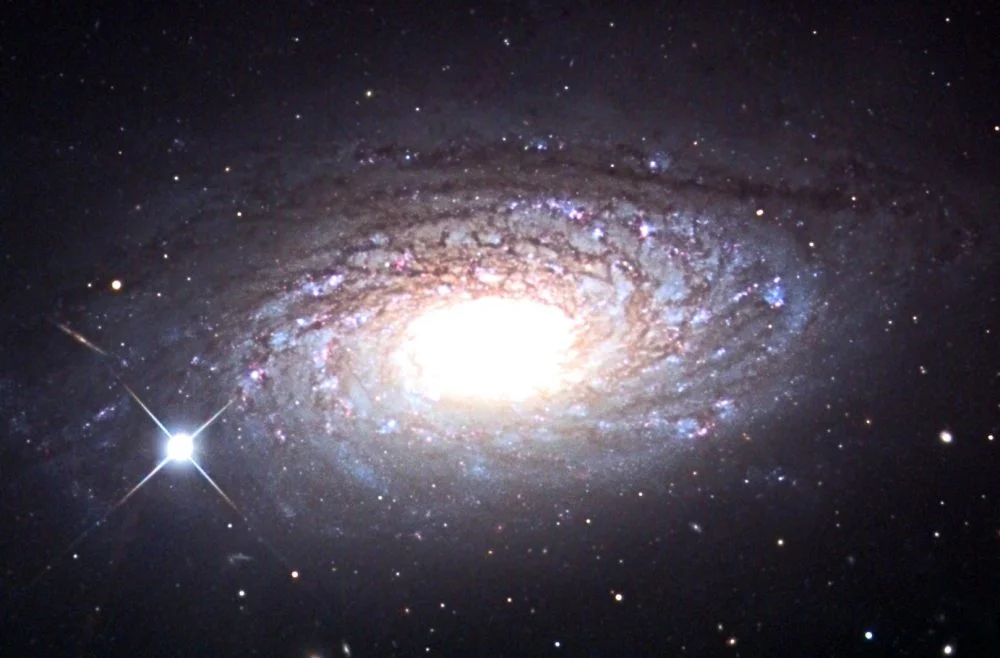
Sunflower Galaxy (Messier 63), image: Wikimedia Commons/Jschulman555
The galaxy was discovered by Pierre Méchain in 1779 and then included in the Messier catalogue by Charles Messier as M63. A supernova was observed in the galaxy in 1971.
Messier 94 (NGC 4736)
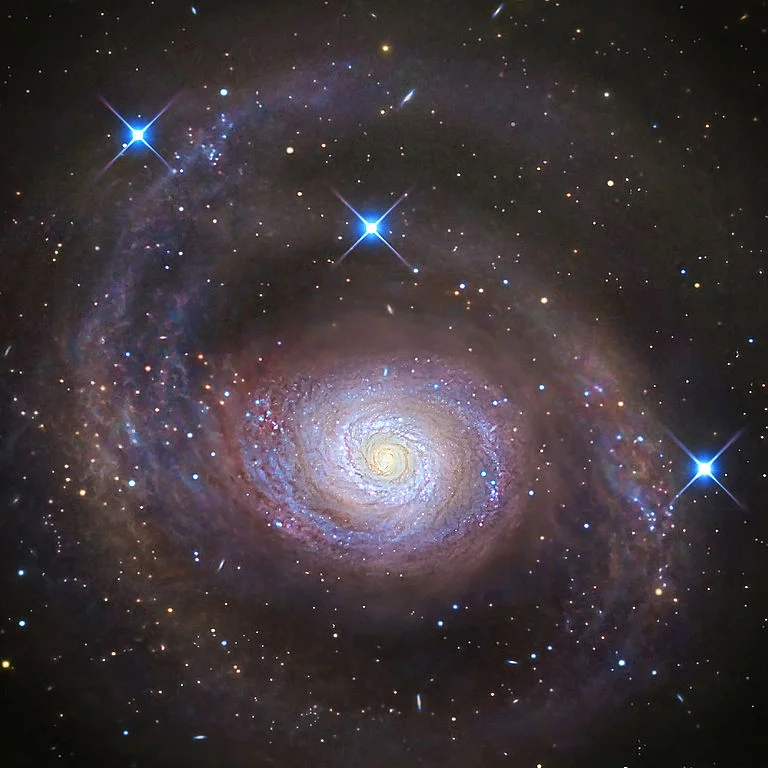
Beautiful spiral galaxy M94 (Messier 94) lies a mere 15 million light-years distant in the northern constellation of the hunting dogs, Canes Venatici. A popular target for astronomers, the brighter inner part of the face-on galaxy is about 30,000 light-years across. Traditionally, deep images have been interpreted as showing M94’s inner spiral region surrounded by a faint, broad ring of stars. But a new multi-wavelength investigation has revealed previously undetected spiral arms sweeping across the outskirts of the galaxy’s disk, an outer disk actively engaged in star formation. At optical wavelengths, M94’s outer spiral arms are followed in this remarkable discovery image, processed to enhance the outer disk structure. Background galaxies are visible through the faint outer arms, while the three spiky foreground stars are in our own Milky Way galaxy. Image: R Jay Gabany (Blackbird Obs.) (CC BY-SA 3.0)
Messier 94 is another spiral galaxy in Canes Venatici, also discovered by Pierre Méchain and catalogued by Messier. It has an apparent magnitude of 8.99 and is approximately 16 million light years distant.
The galaxy is notable for its two ring structures. The inner ring is sometimes referred to as the starburst ring. It has a diameter of 70’’ and is a site of strong star formation activity. The outer ring has a diameter of 600’’ and is not a closed stellar ring, but has a complex structure of spiral arms.
M94 is one of the brightest galaxies in the M94 Group (Canes Venatici I Group), which contains between 16 and 24 galaxies that all lie within the Virgo Supercluster in the constellations Canes Venatici and Coma Berenices.
The M94 Group includes the barred irregular galaxy NGC 4214, the edge-on spiral galaxy NGC 4244 (Caldwell 26) next to the star Beta CVn, the low surface brightness spiral galaxy NGC 4395, the irregular galaxy NGC 4449 (Caldwell 21), and the dwarf irregular galaxy UGC 8320.
Messier 106 (NGC 4258)
Messier 106 is also a spiral galaxy that was discovered by Pierre Méchain in 1781. Its estimated distance from Earth is between 22 and 25 million light years.
M106 is classified as a Seyfert II galaxy, one that has unusual emission lines and emits x-rays, which is why it is suspected that a part of it is falling into a supermassive black hole at its core. M106 has an apparent magnitude of 9.1.
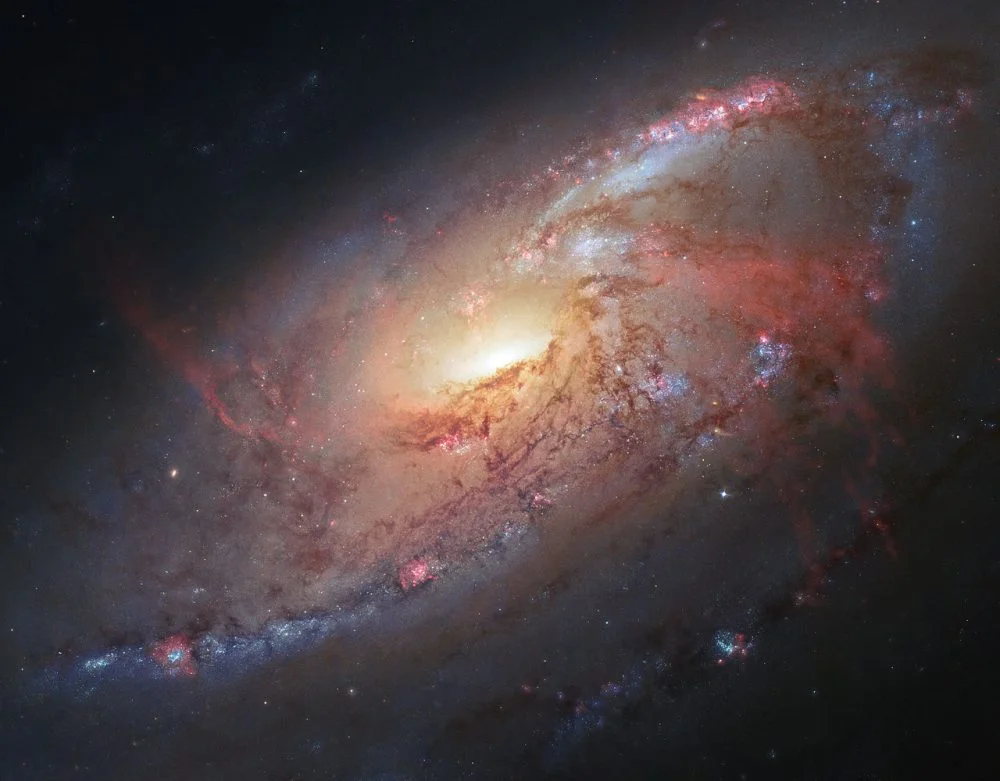
Messier 106. Image: NASA, ESA, the Hubble Heritage Team (STScI/AURA), and R. Gendler (for the Hubble Heritage Team). Acknowledgment: J. GaBany
M51 Group
The M51 Group includes several notable galaxies other than the Whirlpool and Sunflower galaxies.
NGC 5023 is relatively isolated from the group, but is considered a member nonetheless. It is a spiral galaxy, 49,000 light years across, seen edge-on. More than 200 stars in the galaxy have an apparent magnitude greater than 23.5. NGC 5023 is between 17.6 and 26.1 million light years distant. It has an apparent magnitude of 12.82.
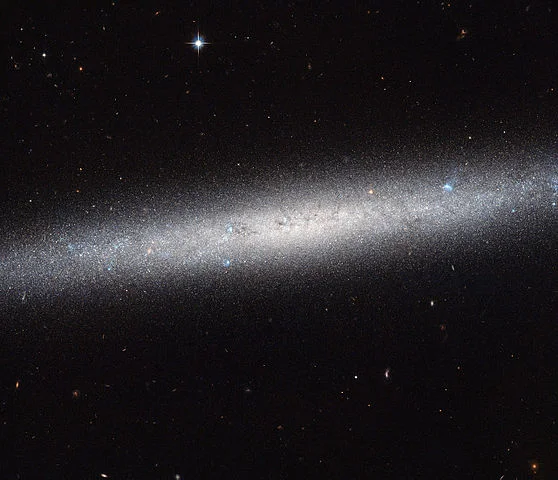
This NASA/ESA Hubble Space Telescope image shows an edge-on view of the spiral galaxy NGC 5023. Due to its orientation we cannot appreciate its spiral arms, but we can admire the elegant profile of its disc. The galaxy lies over 30 million light-years away from us. NGC 5023 is part of the M51 group of galaxies. The brightest galaxy in this group is Messier 51, the Whirlpool Galaxy, which has been captured by Hubble many times. NGC 5023 is less fond of the limelight and seems rather unsociable in comparison — it is relatively isolated from the other galaxies in the group. Astronomers are particularly interested in the vertical structure of discs like these. By analysing the structure above and below the central plane of the galaxy they can make progress in understanding galaxy evolution. Astronomers are able to analyse the distribution of different types of stars within the galaxy and their properties, in particular how well evolved they are on the Hertzsprung–Russell Diagram — a scatter graph of stars that shows their evolution. NGC 5023 is one of six edge-on spiral galaxies observed as part of a study using Hubble’s Advanced Camera for Surveys. They study this vertical distribution and find a trend which suggests that heating of the disc plays an important role in producing the stars seen away from the plane of the galaxy. In fact, NGC 5023 is pretty popular when it comes to astronomers, despite its unsociable behaviour. The galaxy is also one of 14 disc galaxies that are part of the GHOSTS survey — a survey which uses Hubble data to study galaxy halos, outer discs and star clusters. It is the largest study to date of star populations in the outskirts of disc galaxies. The incredible sharp sight of Hubble has allowed scientist to count more than 30 000 individual bright stars in this image. This is only a small fraction of the several billion stars that this galaxy contains, but the others are too faint to detect individually even with Hubble. Image: ESA/Hubble & NASA
UGC 8331 is an irregular galaxy between 19.7 and 26.8 million light years distant. It has an apparent magnitude of 14.61.
UGC 8313 is another edge-on spiral galaxy, about 19,000 light years in diameter. It is believed to be a companion of the Sunflower Galaxy. UGC has an apparent magnitude of 14.4.
NGC 5229 is yet another edge-on spiral, also pretty isolated from the rest of the group. Its estimated age is 13.7 billion years. The galaxy is about 23,000 light years in diameter and has an apparent magnitude of 14.3.
Whale Galaxy (NGC 4631, Caldwell 32, Arp 281)
The Whale Galaxy is an edge-on spiral galaxy approximately 30 million light years from Earth. It has an apparent magnitude of 9.8. It was nicknamed the Whale because it has a slightly distorted shape that resembles a whale or a herring. The galaxy is also notable for its central starburst region and intense star formation, which results in X-ray and spectral line emission. There is a giant diffuse corona of X-ray emitting gas surrounding the entire galaxy.
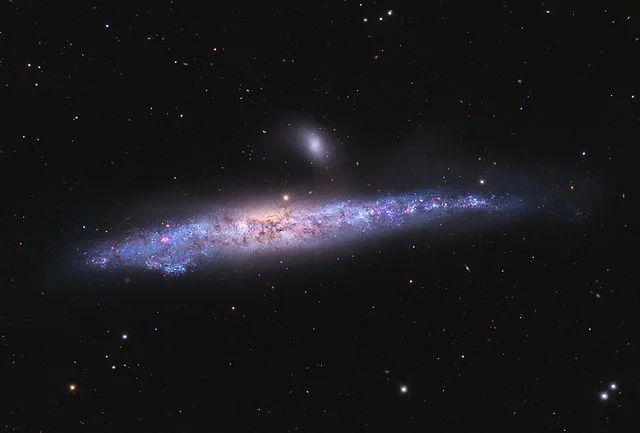
Whale Galaxy (NGC 4631), image: Adam Block/Mount Lemmon SkyCenter/University of Arizona (CC BY-SA 3.0 US)
NGC 5033
NGC 5033 is another spiral galaxy in Canes Venatici. It has an apparent magnitude of 10.8. It appears inclined and has a bright nucleus and a relatively faint disk. The galaxy has a Seyfert nucleus (a type of active galactic nucleus) which is believed to contain a supermassive black hole.

NGC 5033. Image: Adam Block/Mount Lemmon SkyCenter/University of Arizona
The galaxy’s nucleus does not lie at the galaxy’s kinematic centre (that around which the stars rotate), which might indicate that NGC 5033 has undergone a merger with another galaxy.
NGC 5033 is located relatively close to another spiral galaxy, NGC 5005. The two comprise a physical pair and influence each other gravitationally somewhat, but are still distant enough not to be distorted by the tidal forces of the interaction.
NGC 5005 (Caldwell 29)
NGC 5005 is also an inclined spiral galaxy, with a visual magnitude of 10.6. It has a bright nucleus and a bright disk, and can be observed even in large amateur telescopes. The galaxy’s nucleus contains an X-ray source.
NGC 5005 lies approximately 65 million light years from Earth.
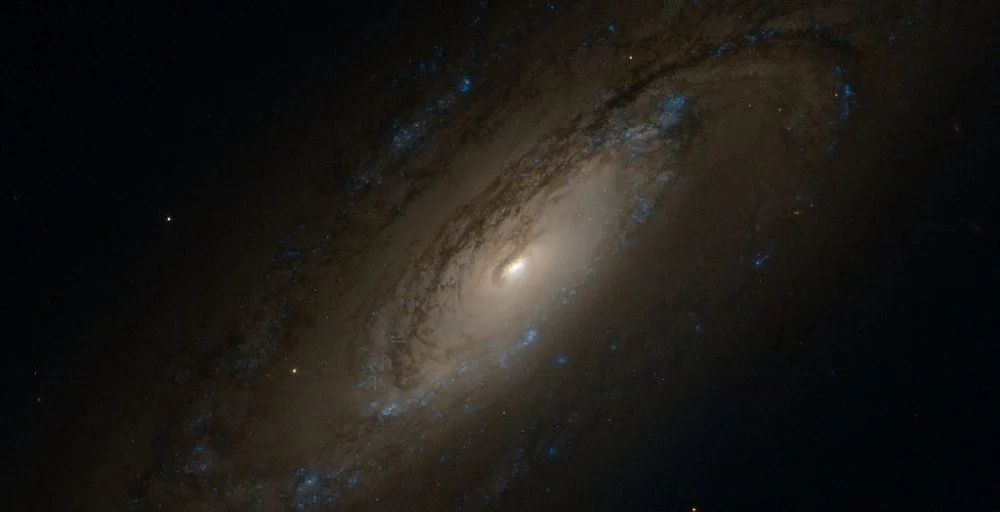
NGC 5005. Image: Judy Schmidt (CC BY 2.0)
NGC 4151
NGC 4151 is an intermediate spiral Seyfert galaxy with an apparent magnitude of 11.5. It is a known X-ray source.
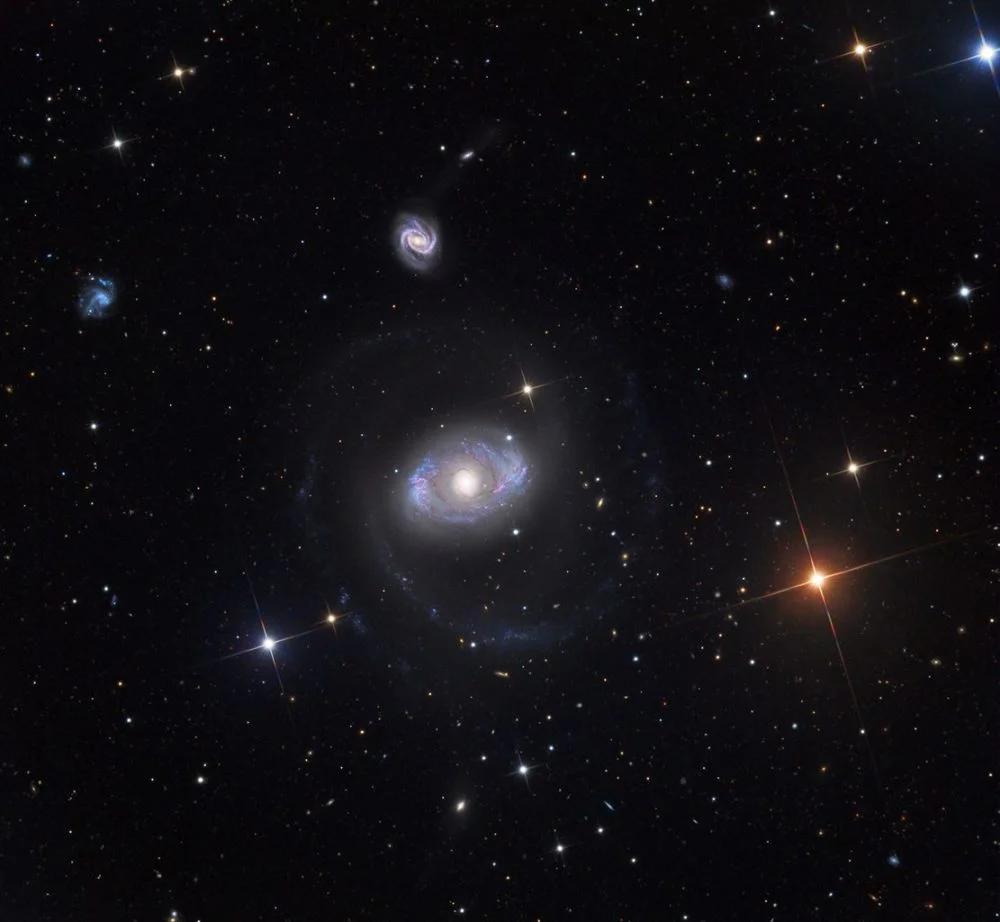
NGC 4151. Image: Adam Block/Mount Lemmon SkyCenter/University of Arizona
NGC 4618
NGC 4618 is a dwarf galaxy with an apparent magnitude of 11.2. It has a distorted shape and a single spiral arm. It is classified as a Sm galaxy and sometimes referred to as a Magellanic spiral.
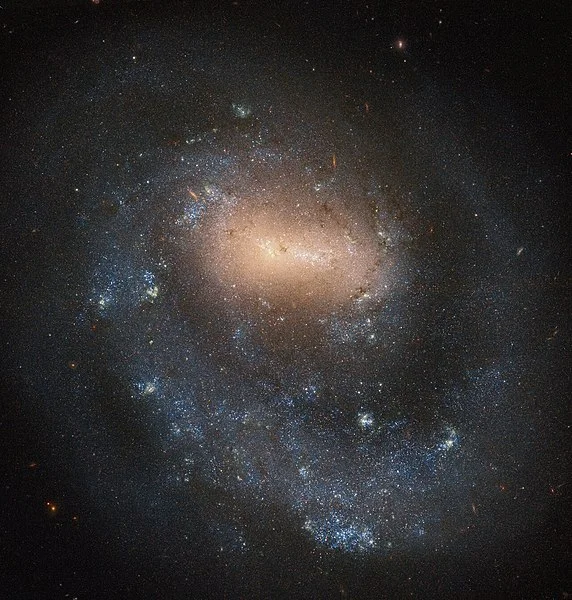
NGC 4618 was discovered on 9 April 1787 by the German-British astronomer, Wilhelm Herschel, who also discovered Uranus in 1781. Only a year before discovering NGC 4618, Herschel theorised that the “foggy” objects astronomers were seeing in the night sky were likely to be large star clusters located much further away then the individual stars he could easily discern. Since Herschel proposed his theory, astronomers have come to understand that what he was seeing was a galaxy. NGC 4618, classified as a barred spiral galaxy, has the special distinction amongst other spiral galaxies of only having one arm rotating around the centre of the galaxy. Located about 21 million light-years from our galaxy in the constellation Canes Venatici, NGC 4618 has a diameter of about one third that of the Milky Way. Together with its neighbour, NGC 4625, it forms an interacting galaxy pair, which means that the two galaxies are close enough to influence each other gravitationally. These interactions may result in the two (or more) galaxies merging together to form a new formation, such as a ring galaxy. Credit: ESA/Hubble & NASA, I. Karachentsev
NGC 4625
NGC 4625 is a dwarf galaxy with an apparent magnitude of 13.2. The galaxy has an asymmetric shape and a single spiral arm. It is classified as a Sm galaxy because its structure somewhat resembles that of a spiral galaxy. NGC 4625 is occasionally referred to as a Magellanic spiral galaxy because its appearance resembles that of the Magellanic clouds (irregular dwarf galaxies in the southern hemisphere, orbiting the Milky Way).
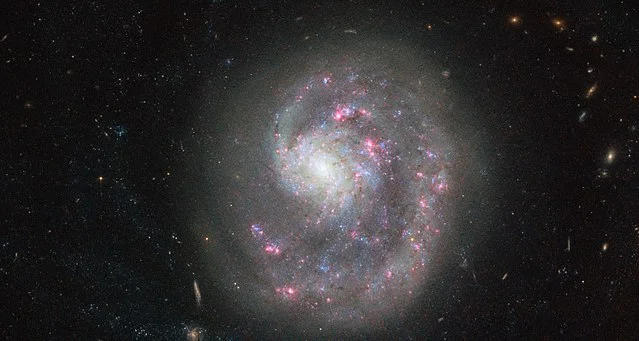
This new Picture of the Week, taken by the NASA/ESA Hubble Space Telescope, shows the dwarf galaxy NGC 4625, located about 30 million light-years away in the constellation of Canes Venatici (The Hunting Dogs). The image, acquired with the Advanced Camera for Surveys (ACS), reveals the single spiral arm of the galaxy, which gives it an asymmetric appearance. But why is there only one spiral arm, when spiral galaxies normally have at least two? Astronomers looked at NGC 4625 in different wavelengths in the hope of solving this cosmic mystery. Observations in the ultraviolet provided the first hint: in ultraviolet light the disc of the galaxy appears four times larger than on the image depicted here. An indication that there are a large number of very young and hot — hence mainly visible in the ultraviolet — stars forming in the outer regions of the galaxy. These young stars are only around one billion years old, about 10 times younger than the stars seen in the optical centre. At first astronomers assumed that this high star formation rate was being triggered by the interaction with another, nearby dwarf galaxy called NGC 4618. They speculated that NGC 4618 may be the culprit “harassing” NGC 4625, causing it to lose all but one spiral arm. In 2004 astronomers found proof for this claim: The gas in the outermost regions of the dwarf galaxy NGC 4618 has been strongly affected by NGC 4625. Image: ESA/Hubble
NGC 5371
NGC 5371 is a spiral galaxy seen face-on. It is classified as a Sbc barred spiral galaxy and located about 100 million light years from Earth. Together with Hickson Galaxy Group 68, NGC 5371 makes up the Big Lick Galaxy Group.
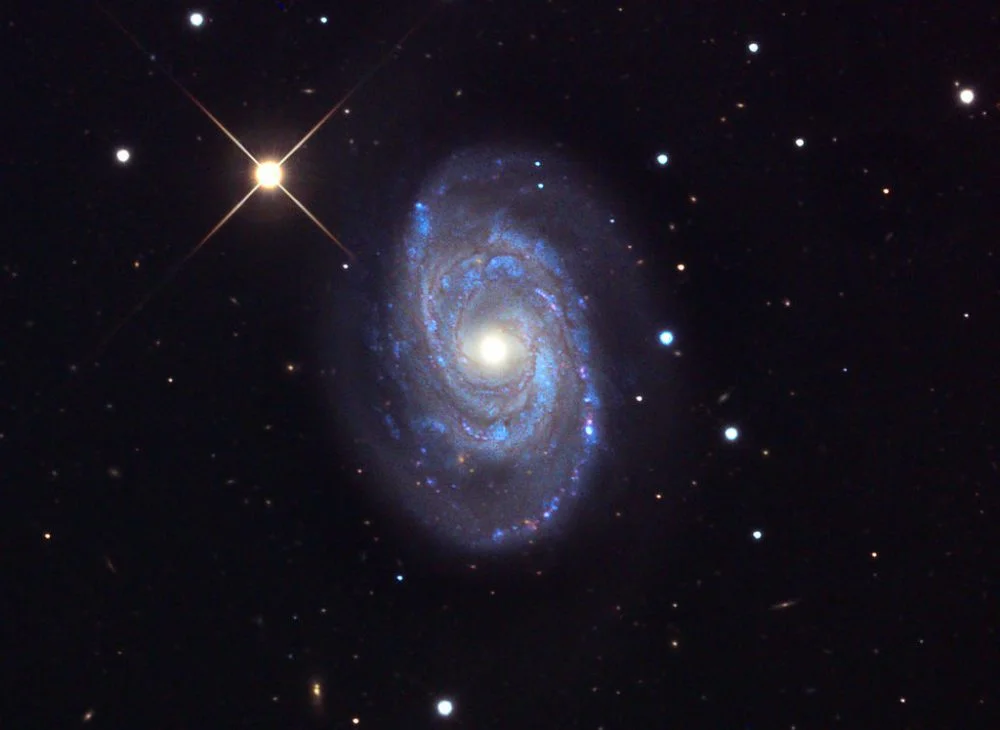
NGC 5371, image: Wikimedia Commons/Jschulman555 (CC BY 3.0)
Hockey Stick Galaxies (Crowbar Galaxy) – NGC 4656 and NGC 4657
NGC 4656 and NGC 4657 are interacting galaxies with an apparent magnitude of 11.0. They both belong to the NGC 4631 Group, a group of galaxies approximately 25 million light years from Earth in the constellations Canes Venatici and Coma Berenices. Other than the Whale (NGC 4631) and Hockey Stick Galaxies, the dwarf elliptical galaxy NGC 4627 also belongs to the group.
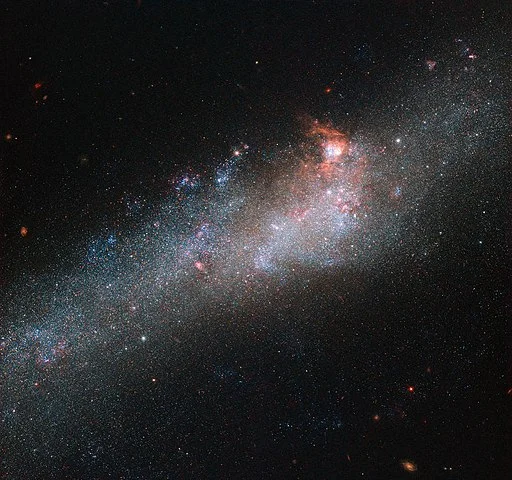
The star of this Hubble image is a galaxy known as NGC 4656, located in the constellation of Canes Venatici (the Hunting Dogs). However, it also has a somewhat more interesting and intriguing name: the Hockey Stick Galaxy! The reason for this is a little unclear from this partial view, which shows the bright central region, but the galaxy is actually shaped like an elongated, warped stick, stretching out through space until it curls around at one end to form a striking imitation of a celestial hockey stick. This unusual shape is thought to be due to an interaction between NGC 4656 and a couple of near neighbors, NGC 4631 (otherwise known as the Whale Galaxy) and NGC 4627 (a small elliptical). Galactic interactions can completely reshape a celestial object, shifting and warping its constituent gas, stars, and dust into bizarre and beautiful configurations. Image: NASA (Hubble Space Telescope)
NGC 4183
NGC 4183 is a spiral galaxy located at an approximate distance of 55 million light years from Earth. It spans about 80,000 light years. The galaxy was discovered by William Herschel on January 14, 1788.
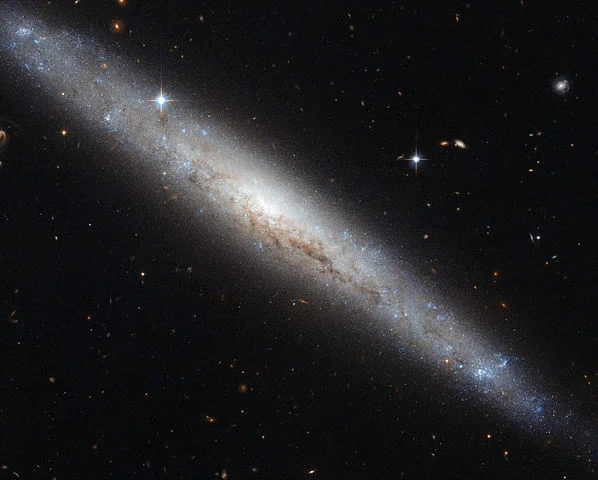
NGC 4183 is a spiral galaxy with a faint core and an open spiral structure. Unfortunately, this galaxy is viewed edge-on from the Earth, and we cannot fully appreciate its spiral arms. But we can admire its galactic disc. The discs of galaxies are mainly composed of gas, dust and stars. There is evidence of dust over the galactic plane, visible as dark intricate filaments that block the visible light from the core of the galaxy. In addition, recent studies suggest that this galaxy may have a bar structure. Galactic bars are thought to act as a mechanism that channels gas from the spiral arms to the centre, enhancing star formation, which is typically more pronounced in the spiral arms than in the bulge of the galaxy. This picture was created from visible and infrared images taken with the Wide Field Channel of the Advanced Camera for Surveys. The field of view is approximately 3.4 arcminutes wide. Image: ESA/Hubble & NASA. Acknowledgement: Luca Limatola
NGC 4214
NGC 4214 is a dwarf barred irregular galaxy with an apparent magnitude of 10.2. It lies approximately 10 million light years from Earth and occupies an area 8.4′ by 6.6′ in size. It is a starburst galaxy, with two vast star-forming regions (NGC 4214-I and NGC 4214-II) found in the galaxy’s centre.
The galaxy also contains two super star clusters, both about 200 million years old. NGC 4214 is brighter and larger than the Small Magellanic Cloud (SMC), the more famous dwarf irregular galaxy located in the constellations Tucana and Hydrus.
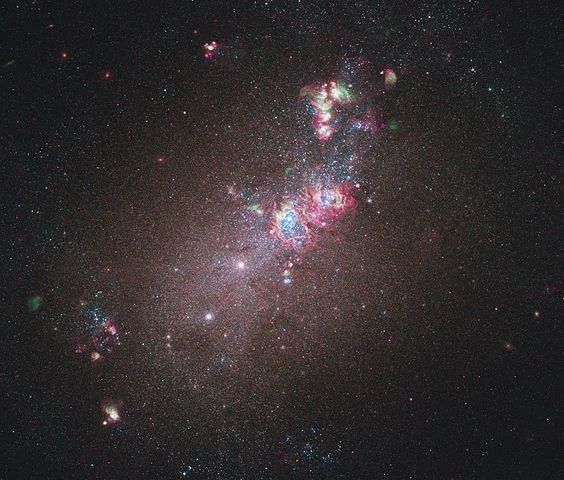
Galaxy NGC 4214, pictured here in an image from the NASA/ESA Hubble Space Telescope’s newest camera, is an ideal location to study star formation and evolution. Dominating much of the galaxy is a huge glowing cloud of hydrogen gas in which new stars are being born. A heart-shaped hollow — possibly galaxy NGC 4214’s most eye-catching feature — can be seen at the centre of this. Inside this cavity lies a large cluster of massive, young stars ranging in temperature from 10 000 to 50 000 degrees Celsius. Their strong stellar winds are responsible for the creation of this bubble. These features have the effect of stemming any further star formation due to the subsequent lack of gas. Image: NASA, ESA and the Hubble Heritage Team (STScI/AURA)-ESA/Hubble Collaboration Acknowledgment: R. O’Connell (University of Virginia) and the WFC3 Scientific Oversight Committee
Cocoon Galaxy (NGC 4490)
The Cocoon Galaxy is a barred spiral galaxy that interacts with a smaller irregular companion, NGC 4485, and is a starburst galaxy as a result. Both galaxies have been distorted by the interaction.
The Cocoon Galaxy is located at a distance of 25.1 million light years from Earth and has an apparent magnitude of 9.8. It was discovered by William Herschel in 1788. Two supernovae have been detected in the galaxy, SN 1982F in 1982 and SN 2008ax in 2008.
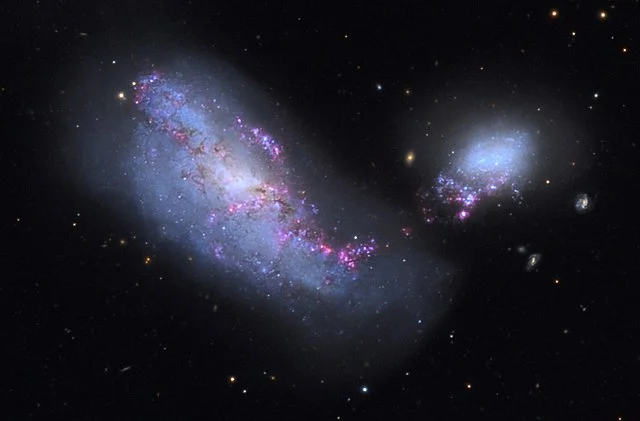
Cocoon Galaxy (NGC 4490). Image: Adam Block/Mount Lemmon SkyCenter/University of Arizona
IC 883
IC 883 (Arp 193) is an irregular galaxy located at an approximate distance of 321 million light years from Earth. The galaxy has a visual magnitude of 13.8 and an apparent size of 2.4’ x 0.7’. It was discovered by the Austrian astronomer Rudolf Ferdinand Spitaler on May 1, 1891.
IC 883 has twin tidal tails, which has led astronomers to believe that it was the remnant of the merger of two disk galaxies, which also triggered a burst of star formation in the region.
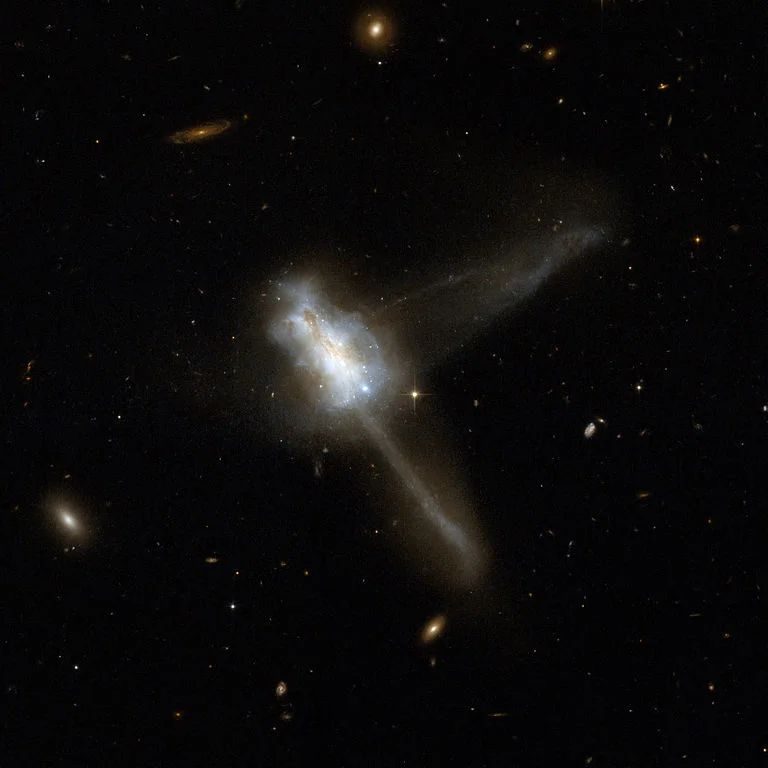
IC 883. Image: NASA, ESA, the Hubble Heritage (STScI/AURA)-ESA/Hubble Collaboration, and A. Evans (University of Virginia, Charlottesville/NRAO/Stony Brook University)
NGC 4449
NGC 4449 is an irregular galaxy about 12 million light years away. It has a visual magnitude of 10 and an apparent size of 6.2′ x 4.4′. The galaxy is part of the M94 Group and similar in size and brightness to the better known Large Magellanic Cloud (LMC), located in the constellations Dorado and Mensa.
NGC 4449, however, has twice the rate of star formation than the Large Magellanic Cloud and is considered a starburst galaxy. It is home to several massive young star clusters, one of which is found in the galaxy’s centre. The galaxy has a distorted shape as a result of interactions with its neighbours.
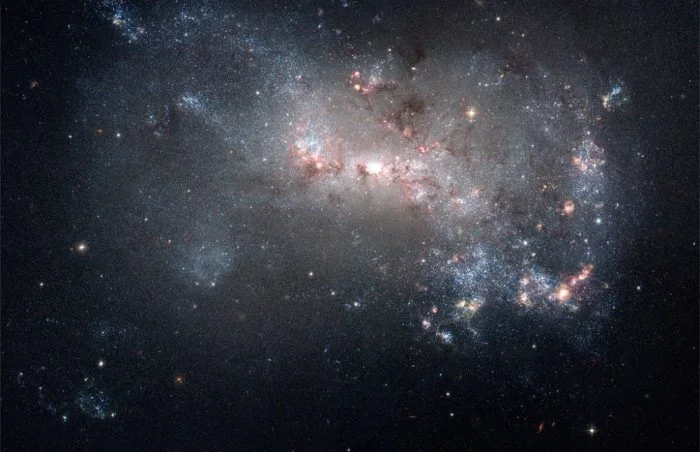
Hundreds of thousands of vibrant blue and red stars blaze in this image taken by NASA’s Hubble Space Telescope. Hot bluish-white clusters of massive stars are scattered throughout the galaxy, interspersed with numerous dustier, reddish regions of current star formation. Massive dark clouds of gas and dust are silhouetted against the starlight. NGC 4449 has been forming stars for several billion years, but currently it is experiencing a star formation event at a much higher rate than in the past. This intense star formation activity qualifies as a starburst. At the current rate, the gas supply that feeds the stellar production would only last for another billion years or so. Starbursts usually occur in the central regions of galaxies, but NGC 4449 has more widespread star formation activity, since the very youngest stars are observed both in the nucleus and in lanes surrounding the galaxy. A global starburst like NGC 4449 resembles primordial star forming galaxies, which grew by merging with and accreting smaller stellar systems. Since NGC 4449 is close enough to be observed in great detail, it is the ideal laboratory for the investigation of what may have occurred during galactic formation and evolution in the early universe. It’s likely that the current widespread starburst was triggered by interaction or merging with a smaller companion. NGC 4449 belongs to a group of galaxies in the constellation Canes Venatici. Astronomers think that NGC 4449’s star formation has been influenced by interactions with several of its neighbors. Image: NASA, ESA, A. Aloisi (STScI/ESA), and The Hubble Heritage (STScI/AURA)-ESA/Hubble Collaboration
Other deep sky objects in Canes Venatici include the dwarf elliptical galaxy NGC 4627, the elliptical galaxy NGC 5223, the lenticular galaxy NGC 4138, the edge-on spiral galaxies NGC 4244 and NGC 4217, the spirals NGC 5002, NGC 5112, and NGC 4534, and the dwarf spheroidal galaxies Canes Venatici I and Canes Venatici II.